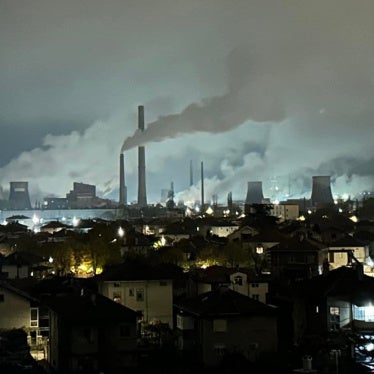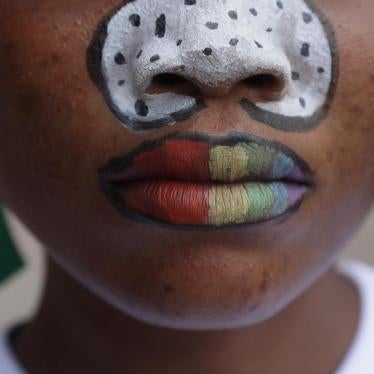(Geneva) - Burma’s allies, including China, Thailand, India and Russia, should urge the Burmese military government to address the peaceful political protests by Buddhist monks and civilians throughout Burma without violence, Human Rights Watch said today. The military government and its State Peace and Development Council (SPDC), should release all demonstrators arbitrarily arrested since protests broke out in August.
Human Rights Watch is deeply concerned that the Burmese military will soon use force to end the peaceful protests. The government has banned all public assemblies, including gatherings of more than five persons, and announced a curfew from 9 p.m. to 5 a.m. Media reports say that tonight troops have been placed around the Sule pagoda in Rangoon, one of the focal points for demonstrators in recent days. Human Rights Watch has also received reports that military units have been positioned outside major cities and towns to prepare to raid Buddhist monasteries and arrest key leaders of the demonstrations and to prevent further demonstrations. There are also credible reports that medical personnel in Rangoon are preparing for casualties resulting from military actions to disperse protestors.
Today, military trucks reportedly drove through the streets of Rangoon with loudspeakers warning civilians not to join in demonstrations. The government-controlled Buddhist monkhood organization has also issued a directive ordering monks against joining “illegal” organizations, a clear threat to young monks taking a leadership role in these protests. There are unconfirmed reports that Burmese military personnel are infiltrating the ranks of the monks to act as agent provocateurs.
“The Burmese military has shown in the past a willingness to kill peaceful protestors to end demonstrations,” said Brad Adams, Asia director at Human Rights Watch. “If the military government is going to listen to anyone, it will be countries with which it has close military and economic ties. Now is the time for these countries to show that they care about the health and welfare of the Burmese people.”
Demonstrations led by monks are the latest phase in over a month of protests sparked by sharp fuel price hikes on August 15, which produced an outcry over continued economic hardships for most Burmese. Over 150 political activists, including many leaders of the 88 Generation Students who led demonstrations during the 1988 uprising against military rule, were arrested after a series of small demonstrations in Rangoon protesting government economic and political policies. Many dissidents continue to be arrested and are reportedly being subject to torture and other mistreatment. Human Rights Watch called on the SPDC to immediately permit prison visits by impartial humanitarian agencies to inspect conditions and provide necessary medical care to detainees.
Dissatisfaction in Burma has also been fuelled by the conclusion of the 14-year-long National Convention process on September 3. Many groups, including ethnic nationality groups that participated in the process, believe that the heavily controlled convention will not lead to political reform or an end to military rule. Some ethnic nationality groups that have reached ceasefire agreements with the government have hinted that they may resume armed conflict against the government if their basic demands are not addressed. Many of these groups are publicly expressing support for the demonstrations in Rangoon and elsewhere.
In a statement to the UN Human Rights Council (HRC) on Monday, Human Rights Watch called for the council to hold an emergency session to address the situation in Burma and to take preventive measures to avoid violence. The UN High Commissioner for Human Rights, Louise Arbour, condemned arrests of peaceful demonstrators in Burma, and called for their release in an address to the Human Rights Council on September 13. Three UN human rights experts appointed by the council, including one who is responsible for addressing the situation in Burma, also urged the HRC to take action in a statement issued that day.
Even prior to recent events, China, Russia and South Africa had said that the Human Rights Council was the appropriate place for addressing the situation in Burma, which was an explanation of their decision to vote against a Security Council resolution in January condemning Burma. Ten additional countries raised concerns over unfolding events in Burma in the Human Rights Council’s ongoing regular session yesterday, but no further action was taken.
“Those who blocked action at the Security Council said that the situation in Burma was the responsibility of the Human Rights Council,” said Adams. “Now it is time for them to show that they meant what they said. The council cannot simply sit back and watch as the situation in Burma deteriorates.”
The Burmese military has a long record of using force to put down peaceful demonstrations. In 1988, demonstrations against military rule eventually deposed the government, but led to a coup d’etat by military commanders who formed the State Law and Order Restoration Council, the predecessor to the SPDC. Demonstrators in Rangoon were shot in the streets in a series of brutal military operations that also targeted monks and medical personnel. No official investigation has ever taken place, but the best estimates suggest that approximately 3,000 people were killed as the demonstrations were crushed in September 1988. As many as 10,000 people were killed nationwide between March and September of that year.
In 1990, following a months-long monk boycott in Mandalay, authorities tortured to death several monks and arrested and imprisoned hundreds to end the boycott. Demonstrations in December 1996, in which hundreds of university students staged peaceful night-time rallies calling for political reforms, were crushed by security forces. Hundreds of students were arrested and many were forced to flee the country.
In 2003, in a respite from her long periods of house arrest, opposition leader Aung San Suu Kyi undertook a series of public speaking events. As she visited towns in western and northern Burma, her speeches drew increasingly large crowds, some in the tens of thousands. When the military felt threatened by the growing public support, it unleashed a violent crackdown in Depayin in Upper Burma. Several of Suu Kyi’s supporters were killed and hundreds arrested. Aung San Suu Kyi was then detained in Insein prison in Rangoon. She has been under house arrest since.
Until the latest wave of protests, there have only been sporadic demonstrations in the cities and countryside by small groups of demonstrators, as most Burmese civilians have feared a violent government response.
“The best way to avoid violence is for the SPDC to release political activists and begin a serious political dialogue with opposition parties, ethnic groups, and others,” Adams said. “The obligation of the international community, particularly Burma’s allies, is to press the military to do that, including through a special session of the Human Rights Council. Anything less is tantamount to support for prolonged military rule and an endorsement of the clearly bankrupt political and economic system the generals have constructed.”






